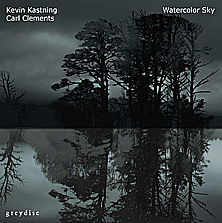 Truly
an album of inspirational music making, Watercolor Sky is
the 2014 collaboration recording by guitarist Kevin Kastning and
horn / woodwinds player Carl Clements. The duo’s 2013
CD Nowhere, Now Here was more dynamic than their first album,
Dreaming As I Knew, and 2014's Watercolor Sky presents
an even more in depth look into their mix of acoustic guitar and sax.
Commenting on the duo's three albums together, Kastning explains,
'These
three records are separate entities; not really connected; though
each may build off the previous. Each record has its own direction
and concept, and the only influence from our previous records is that
we agree we don't want to repeat any previous concepts or directions.
For example, we have our fourth record almost completely recorded,
and it's a departure from Watercolor Sky. I think each record moves
things forward in an expansive way', with
Clements further adding,
'I
do see the conceptions of each of our albums so far as being both
progressive and distinct. They’re progressive in the sense that
our rapport and reservoir of ideas continues to grow, and we’re
constantly exploring new directions, concepts, and even instruments
and instrumental combinations.' Calling
Kastning just an acoustic guitarist would be a disservice. Scripting
his albums like spatial instrumental soundtracks, Kastning appears
more like the Rod Serling of the 36 string double contra guitar, directing
his latest instrument which he debuts on this album. The music that
Kastning and Clements create together on Watercolor Sky is
beyond words, more like the soundtrack to an M.C. Esher painting.
Intricate, prismatic are words you could use to describe Watercolor
Sky. From the eerie cover art / Rohr shock painting on the cover,
to the rich sonic details and calculus of Kastning’s piano like
36 string guitar and the wide range of Clements’ towery horns,
Watercolor
Sky is a total sonic trip well worth taking. Kevin
Kastning
/ Carl
Clements
Truly
an album of inspirational music making, Watercolor Sky is
the 2014 collaboration recording by guitarist Kevin Kastning and
horn / woodwinds player Carl Clements. The duo’s 2013
CD Nowhere, Now Here was more dynamic than their first album,
Dreaming As I Knew, and 2014's Watercolor Sky presents
an even more in depth look into their mix of acoustic guitar and sax.
Commenting on the duo's three albums together, Kastning explains,
'These
three records are separate entities; not really connected; though
each may build off the previous. Each record has its own direction
and concept, and the only influence from our previous records is that
we agree we don't want to repeat any previous concepts or directions.
For example, we have our fourth record almost completely recorded,
and it's a departure from Watercolor Sky. I think each record moves
things forward in an expansive way', with
Clements further adding,
'I
do see the conceptions of each of our albums so far as being both
progressive and distinct. They’re progressive in the sense that
our rapport and reservoir of ideas continues to grow, and we’re
constantly exploring new directions, concepts, and even instruments
and instrumental combinations.' Calling
Kastning just an acoustic guitarist would be a disservice. Scripting
his albums like spatial instrumental soundtracks, Kastning appears
more like the Rod Serling of the 36 string double contra guitar, directing
his latest instrument which he debuts on this album. The music that
Kastning and Clements create together on Watercolor Sky is
beyond words, more like the soundtrack to an M.C. Esher painting.
Intricate, prismatic are words you could use to describe Watercolor
Sky. From the eerie cover art / Rohr shock painting on the cover,
to the rich sonic details and calculus of Kastning’s piano like
36 string guitar and the wide range of Clements’ towery horns,
Watercolor
Sky is a total sonic trip well worth taking. Kevin
Kastning
/ Carl
Clements
mwe3.com presents an interview with
Kevin Kastning and Carl Clements
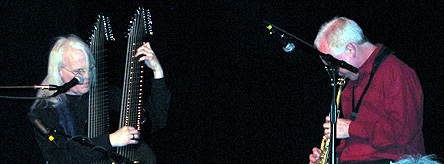 mwe3:
The 2014 CD release of Watercolor Sky follows the earlier Kastning
/ Clements CD releases Dreaming As I Knew and Nowhere, Now
Here. Is there a trilogy of ideas moving forward and culminating
on your new album? You mentioned Nowhere, Now Here was much
more dynamic than its predecessor so, in what ways does Watercolor
Sky pick up the torch and move things forward sonically and compositionally
so to speak?
mwe3:
The 2014 CD release of Watercolor Sky follows the earlier Kastning
/ Clements CD releases Dreaming As I Knew and Nowhere, Now
Here. Is there a trilogy of ideas moving forward and culminating
on your new album? You mentioned Nowhere, Now Here was much
more dynamic than its predecessor so, in what ways does Watercolor
Sky pick up the torch and move things forward sonically and compositionally
so to speak?
Kevin Kastning: I wouldn't say a trilogy. These three records
are separate entities; not really connected; though each may build
off the previous. Each record has its own direction and concept, and
the only influence from our previous records is that we agree we don't
want to repeat any previous concepts or directions. For example, we
have our fourth record almost completely recorded, and it's a departure
from Watercolor Sky. I think each record moves things forward
in an expansive way; Watercolor Sky brings a kind of meditative
element with it; almost an inward reflective or separate emotional
state. Whereas Nowhere, Now Here was denser in texture than
Dreaming As I Knew, Watercolor Sky is far more sparse
and austere; more evocative.
 Carl
Clements: I wouldn’t call it a trilogy, as it’s an ongoing
effort that will include more than three albums. But I do see the
conceptions of each of our albums so far as being both progressive
and distinct. They’re progressive in the sense that our rapport
and reservoir of ideas continues to grow, and we’re constantly
exploring new directions, concepts, and even instruments and instrumental
combinations. They’re distinct in so far as we look back on our
previous work and try to think of how we can build on it and explore
some directions that we haven’t previously delved into fully.
For Watercolor Sky, we chose to feature tracks that explored
a somewhat more meditative direction. We didn’t really set out
to do this at the start, but when it came down to deciding which of
our recently recorded tracks to feature on the album, we realized
that we had a strong selection of tracks that were very spacious and
introspective. We thought it might be interesting to put them together
on a single album to present this side of our playing. It was a bit
of an experiment, but so far the response has been very positive.
This is also the first album to feature Kevin’s 36 string Double
Contraguitar, so it is sonically distinct in that regard, as well.
Carl
Clements: I wouldn’t call it a trilogy, as it’s an ongoing
effort that will include more than three albums. But I do see the
conceptions of each of our albums so far as being both progressive
and distinct. They’re progressive in the sense that our rapport
and reservoir of ideas continues to grow, and we’re constantly
exploring new directions, concepts, and even instruments and instrumental
combinations. They’re distinct in so far as we look back on our
previous work and try to think of how we can build on it and explore
some directions that we haven’t previously delved into fully.
For Watercolor Sky, we chose to feature tracks that explored
a somewhat more meditative direction. We didn’t really set out
to do this at the start, but when it came down to deciding which of
our recently recorded tracks to feature on the album, we realized
that we had a strong selection of tracks that were very spacious and
introspective. We thought it might be interesting to put them together
on a single album to present this side of our playing. It was a bit
of an experiment, but so far the response has been very positive.
This is also the first album to feature Kevin’s 36 string Double
Contraguitar, so it is sonically distinct in that regard, as well.
mwe3: How does the addition of the 36 string Double Contraguitar
on Watercolor Sky increase the sonic spectrum so to speak and
how does it change and/or enhance the sound in contrast to the 30
string Contraguitar? I also noticed in the Watercolor Sky liner
notes, that you have listed which tracks feature the 30 string and
which feature the 36 string. What should the listeners keep an ear
out for to pick up on the sonic differences between the 30 and 36
string guitar sound?
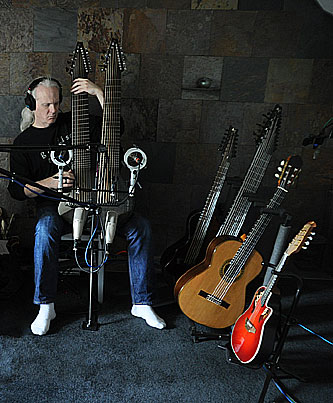 Kevin
Kastning: The addition of the 36 increases the sonic spectrum
in a couple of ways. The most immediate being that it allows for two
Contraguitar tunings on the same instrument. So one neck is in all
octave tunings, and the other is in one of my intervallic tunings.
It allows for new techniques and possibilities; one example is that
I can simultaneously play a bass line on one side, while tapping upper-register
chords or melodic lines on the other; almost in a Chapman stick approach.
Or I can use my right hand to simultaneously play both sets of strings.
Another sonic impact is that by having the octave tunings covered
by one neck of the 36, it allows me to put the Contra side of the
30-string into yet another tuning. Ergo, I have three different Contraguitar
tunings right there. This expands my harmonic palette in ways unimaginable
just a few years ago.
Kevin
Kastning: The addition of the 36 increases the sonic spectrum
in a couple of ways. The most immediate being that it allows for two
Contraguitar tunings on the same instrument. So one neck is in all
octave tunings, and the other is in one of my intervallic tunings.
It allows for new techniques and possibilities; one example is that
I can simultaneously play a bass line on one side, while tapping upper-register
chords or melodic lines on the other; almost in a Chapman stick approach.
Or I can use my right hand to simultaneously play both sets of strings.
Another sonic impact is that by having the octave tunings covered
by one neck of the 36, it allows me to put the Contra side of the
30-string into yet another tuning. Ergo, I have three different Contraguitar
tunings right there. This expands my harmonic palette in ways unimaginable
just a few years ago.
One of the sonic differences between the two instruments is that the
voicings are different on all three necks. Even though they are all
18-string double-course instruments, each really has its own voice;
its own sonic fingerprint. I don't mean due to the three different
tunings, though that is certainly three distinct and separate voices.
I mean that were all three in the exact same tuning, you'd be able
to discern three different voices, like three different instruments,
as they were all voiced differently when they were designed and built.
The Contraguitar on the 30-string is a bit more forward and brighter;
whereas the overall voicing on the 36 is more balanced and has a bit
more response in the bass and sub-bass registers.
One other key difference is that the 30-string is fretless in its
upper registers. This allows for some unique and interesting fretless
work, voices, effects, and possibilities. The 36 is not; both necks
are double-octave 24-frets, so I have a more workable extreme upper
register for chords and polyphony on the 36 than on the 30, which
due to the fretless area is more monophonic and linear.
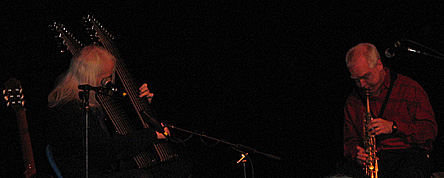 Carl
Clements: I’m sure Kevin will have more to say about this
than I will, but there are a number of aspects of the 36 string Double
Contraguitar that stand out for me. One is the almost orchestral aspect
of having so many strings immediately available, which allows for
very rich textures. Another is the fact that the tuning on the two
necks of the guitar are significantly different. As I understand it,
one neck is tuned primarily in octave or unison pairs, and the other
is tuned primarily in more dissonant pairs of 2nds and 9ths. While
Kevin has used each of these tuning concepts in the past, the double-neck
guitar allows him to have both tunings readily available during a
single track. This certainly expands his palette.
Carl
Clements: I’m sure Kevin will have more to say about this
than I will, but there are a number of aspects of the 36 string Double
Contraguitar that stand out for me. One is the almost orchestral aspect
of having so many strings immediately available, which allows for
very rich textures. Another is the fact that the tuning on the two
necks of the guitar are significantly different. As I understand it,
one neck is tuned primarily in octave or unison pairs, and the other
is tuned primarily in more dissonant pairs of 2nds and 9ths. While
Kevin has used each of these tuning concepts in the past, the double-neck
guitar allows him to have both tunings readily available during a
single track. This certainly expands his palette.
Kevin Kastning: Orchestral is the right word for it!
mwe3: Last time, Carl mentioned Nowhere, Now Here was
exciting in part because both of you were playing new instruments
that you hadn’t recorded with earlier. Was there that same level
of excitement this time as well and can Carl specify or indicate any
additions or changes to his equipment on the Watercolor Sky album?
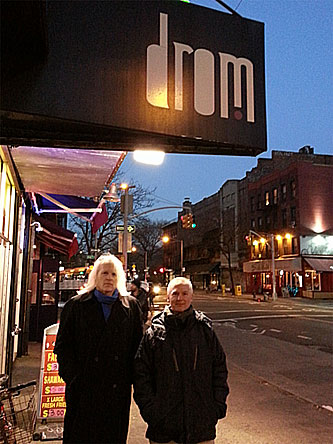 Kevin
Kastning: Yes, I think there was. There was the additional possibilities
and horizons provided by the 36. When we were in the recording sessions
for the album that would become Watercolor Sky, the 30-string
was only a year old, so that was (and still is) a new instrument with
new possibilities. Add to that the sheer vastness of the 36, and for
me it was certainly exciting. Watercolor Sky is the first album,
the recording debut, for the 36. In fact, for Watercolor Sky, I
only played the 30 and 36 on the entire record. This was only the
second album utilizing Carl's alto flute, so for me, that also still
seemed like a new voice and an extension of our harmonic and melodic
compositional landscapes. Bringing his alto flute together with the
30 and 36 created some new soundscapes for us.
Kevin
Kastning: Yes, I think there was. There was the additional possibilities
and horizons provided by the 36. When we were in the recording sessions
for the album that would become Watercolor Sky, the 30-string
was only a year old, so that was (and still is) a new instrument with
new possibilities. Add to that the sheer vastness of the 36, and for
me it was certainly exciting. Watercolor Sky is the first album,
the recording debut, for the 36. In fact, for Watercolor Sky, I
only played the 30 and 36 on the entire record. This was only the
second album utilizing Carl's alto flute, so for me, that also still
seemed like a new voice and an extension of our harmonic and melodic
compositional landscapes. Bringing his alto flute together with the
30 and 36 created some new soundscapes for us.
Carl Clements: As mentioned in regard to your last question,
Kevin’s 36 string Double Contraguitar added a great deal to this
album. For myself, I didn’t add any new instruments this time.
But there is a nice diversity of instrumentation, as I play alto flute,
bansuri flute, tenor sax, and soprano sax. For some reason, more of
the tracks are on alto flute than any other instrument. I suppose
this is in part because this is my newest instrument, and it is a
sound I’ve been wanting to explore for years. But I also think
that for the more meditative concept on this album, we found that
the deep resonant sound of the alto flute was conducive to evoking
the kind of textures and timbres that fit well with the album’s
concept. Nonetheless, I’m equally happy with the tracks that
included bansuri flute (the opening track) and tenor and soprano saxes.
mwe3: Were there any different or unique musical influences
or goals on Watercolor Sky, as far as the sounds you were trying
to achieve in the studio this time around? The sound of Watercolor
Sky is very dark in places but it’s just as mesmerizing,
if not more so, as your other CD releases. What inspired you musically,
sonically and in other ways on the Watercolor Sky CD and what
was your mindset like in the studio this time around?
 Kevin
Kastning: Regarding the goals, at the outset of a new album project,
Carl and I spend significant time discussing the direction for the
new record. Probably the best descriptive I can grasp for this record
is "meditative." I think there is a real austerity and sparseness
there, but not in a minimalist way at all. I suspect the darkness
to which you refer may be the depth of the compositional aspects.
Kevin
Kastning: Regarding the goals, at the outset of a new album project,
Carl and I spend significant time discussing the direction for the
new record. Probably the best descriptive I can grasp for this record
is "meditative." I think there is a real austerity and sparseness
there, but not in a minimalist way at all. I suspect the darkness
to which you refer may be the depth of the compositional aspects.
Regarding the influences, Carl and I both have some rather diverse
and deep influences not always shared by the other. For example, Carl
has been and continues to be deeply impacted by Indian classical music,
though I can't claim it as an influence. One of my life-changing influences
is early music, but I don't think that genre has impacted Carl. Whereas
another major area of influence and direction for Carl is jazz, my
main area of influence and impact is classical music. Probably 90%
of what I listen to, study, practice, research, and pursue is classical
music. One element that may have shaded my input on Watercolor
Sky is the music of Korean gauageumist Byungki Hwang. His music
is like an austere wintery landscape; emotional; sparse, but never
minimalist. However, there are some commonalities and influences we
both share; for example, the late-period Beethoven quartets or Jan
Garbarek or the solo works of Keith Jarrett. We also share many nonmusical
artistic influences in the fields of literature, painting, and nature.
I think we've both been and continue to be heavily influenced by these
areas.
Additionally, Carl and I have been playing together for over 29 years;
our first concert together was in 1985. I think it's possible and
even likely that spending that much time together in performances
and recording studios is that each of us may have been, and probably
continues to be, an influence, subliminal or otherwise, on the other.
You can hear this in some passages on Watercolor Sky; while
the album is entirely improvised, many sections do sound composed.
I think that kind of compositional cohesion and structure partially
results from having played together for so long.
Carl Clements: I don’t think we specifically aimed to
draw inspiration from any particular influences, but inevitably, a
lifetime of influences manifests itself in one way or another. Since
I’ve played Hindustani classical music on the bansuri flute for
many years, I believe this is a constant inspiration for me, especially
on more spacious and introspective tracks like the ones we’re
featuring on Watercolor Sky. I also find some resonance in
these tracks with Japanese gagaku music, though this is a very subjective
observation that Kevin might not share. Interestingly, I played my
first concert of traditional Japanese music not long after completing
the recordings for Watercolor Sky, and this might have heightened
my awareness of this aspect of our own music. As far as the studio
mindset, I think one of the things we were aiming for this time around
was a strong sense of space and balance. Of course we always have
these ideas in mind, but this time I think it was more of a conscious
framing for many of the tracks.
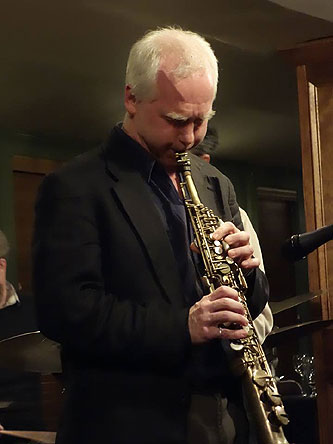 mwe3:
Kevin mentioned last time about how evolutionary and revolutionary
the 30 string guitar sound was and how challenging he felt it was
to master and record with. So lo and behold, instead of reducing strings
he went for another six strings on the 36 string guitar. So compared
to the 30 string, what unique challenges does the 36 string guitar
pose, both as a guitarist and as a composer? Also to combine his sound
with the 36 string guitar, did Carl alter, amplify or diversify his
sound?
mwe3:
Kevin mentioned last time about how evolutionary and revolutionary
the 30 string guitar sound was and how challenging he felt it was
to master and record with. So lo and behold, instead of reducing strings
he went for another six strings on the 36 string guitar. So compared
to the 30 string, what unique challenges does the 36 string guitar
pose, both as a guitarist and as a composer? Also to combine his sound
with the 36 string guitar, did Carl alter, amplify or diversify his
sound?
Kevin Kastning: As a composer, it doesn't bring challenges;
it eliminates them. The 30-string and the 36-string came into existence
due to compositional requirements, limitations, and needs. They don't
bring compositional challenges if challenges are defined as limitations;
they bring compositional possibilities and solutions to compositional
problems and limitations. As a guitarist, it's another story. Because
these instruments have never existed, the required technique is up
to me to discover, find, and learn. Obviously, there's no reference
materials in existence for 30- and 36-string such as there are for
6-string classical guitar. I play them both in a cello posture; vertically
instead of horizontally, and both instruments utilize cello end pins.
When I was designing the 30-string, I didn't know that a cello posture
would be the playing position, though I did suspect it. One technique
I've developed is playing both necks simultaneously. This is an enormous
challenge with which I'm still grappling and no doubt will be for
quite some time. This is why I refer to the 36 as a "36-string"
instrument and not a doubled "18-string" instrument: because
I approach it and the 30 as a single entire instrument; I utilize
the entire instrument at all times instead of merely focusing on one
neck and then switching to the other.
Carl Clements: I’ll leave the first part of this question
to Kevin. For my own part, I wouldn’t say that I needed to change
my approach in terms of amplification or diversification to blend
with the 36 string Double Contraguitar. But as I discussed earlier,
the increased sonic and harmonic possibilities of this guitar certainly
helped pull me in new and interesting directions. As Kevin’s
palette expands, I find myself drawn into new sonic territory.
mwe3: In 2013, Kevin told mwe3.com that Nowhere, Now Here
had more to do with 21st century classical chamber music than
jazz or New Age music. After hearing Watercolor Sky I would
say that comparison is even more accurate. This is truly genre-less
music. Would Watercolor Sky be even more neoclassical in scope,
compared to Nowhere, Now Here and what other musical influences
came into play during the recording process? For instance, how do
Carl’s Hindustani classical and other sonic influences come into
focus on Watercolor Sky?
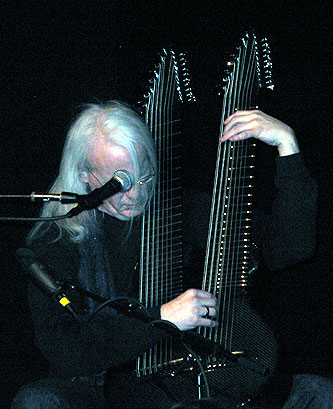 Kevin
Kastning: While I think our music has more to do with 21st-century
classical music, I don't think I'd label it as 21st-century classical.
The compositions are certainly longer and more extended on Watercolor
Sky than our previous records, so that alone may seem to imply
classical influence. Personally, I wouldn't label it as any genre;
I think the influences and genres by which Carl and I have been impacted
and from which we've learned and the forces by which we continue to
be shaped are too diverse. That said, I've heard listeners label it
with the element they hear and with which they identify, which is
understandable. We get airplay on classical, jazz, and even new age
radio; to wit:Watercolor Sky charted on the New Age charts.
I suspect that music which is without genre may reactionarily get
tossed into several genres; as each person hears an element of some
other field of music in it, they think that's what it is. If it helps
people grasp it, I have no problem with that. Personally, there is
music to which I listen that I'd not be able to categorize; for example,
much in the ECM Records catalogue, and I think our music is like that
as well.
Kevin
Kastning: While I think our music has more to do with 21st-century
classical music, I don't think I'd label it as 21st-century classical.
The compositions are certainly longer and more extended on Watercolor
Sky than our previous records, so that alone may seem to imply
classical influence. Personally, I wouldn't label it as any genre;
I think the influences and genres by which Carl and I have been impacted
and from which we've learned and the forces by which we continue to
be shaped are too diverse. That said, I've heard listeners label it
with the element they hear and with which they identify, which is
understandable. We get airplay on classical, jazz, and even new age
radio; to wit:Watercolor Sky charted on the New Age charts.
I suspect that music which is without genre may reactionarily get
tossed into several genres; as each person hears an element of some
other field of music in it, they think that's what it is. If it helps
people grasp it, I have no problem with that. Personally, there is
music to which I listen that I'd not be able to categorize; for example,
much in the ECM Records catalogue, and I think our music is like that
as well.
Carl Clements: This kind of question is intriguing, but always
a bit difficult to address. Kevin and I have a long history in music,
both together and separately. We really do try not to be inhibited
by genre categories or restrictions, and strive for a kind of immediacy
and spontaneity in our interactions and musical development. But we’re
inevitably informed by everything we’ve listened to in the past.
I’d say much more often than not, this is on an unconscious or
subconscious level. In fact, I think there are times when we realize
we’re veering into familiar territory and make it a point to
change the direction into less familiar pathways. There are certainly
times, though, when I will try to capture or explore the energy of
a specific musical style, for example Hindustani classical music.
But I usually try to limit this to an inspiration rather than an emulation.
And there are certain music's that one or the other of us will have
studied more than the other, so we may often be drawing on different
inspirations at the same moment of a recording. This for me just enriches
the experience, and helps prevent the music from becoming predictable
and formulaic. On the other hand, we do share many of the same musical
inspirations, so there is plenty of common ground.
mwe3: Kevin, can you reflect on how you feel you’re developing
as a master of the 30 string and 36 string guitar? Can you also tell
the readers something about your evolution or development as a guitarist?
For instance, how and at what point did you go from six string guitar
to fourteen-string guitar and onwards and upwards? Also can you explain
to the readers how your 30 string and 36 string guitars are different
from harp guitars and other stringed instruments that go beyond the
traditional six and/or seven string guitars? And is there a story
you can share with the readers about the making of the 36 string Double
Contraguitar?
Kevin Kastning: Thank you, Robert; that is very kind of you
to say, but I am the master of nothing. For me, the word "master"
implies that you've reached the pinnacle of the instrument and can
go no farther; for me, nothing could be further from the truth. The
process of learning the 30 and 36 is that of learning new instruments.
As soon as I start feeling as if I'm making some headway with them,
I'll hit upon some new technique or possibilities and feel like I'm
starting over again; it is a humbling path to say the least. It's
a lifelong search. Their secrets are revealed to me slowly over time.
They are very different from harp guitars. Harp guitars are usually
a traditional 6-string with the addition of 3, 5, or 7 low bass drone
strings. Drone strings meaning they're open and have no fingerboard;
therefore each string is capable of exactly one fixed pitch, like
a harp; hence the name. When this is compared to a bass string on
the 36, which is capable of 25 fixed pitches, because all the strings
are on the fingerboard, it's really not a fair comparison. I've heard
some lovely music performed on harp guitar, but it doesn't appeal
to me for my music; it's too limiting.
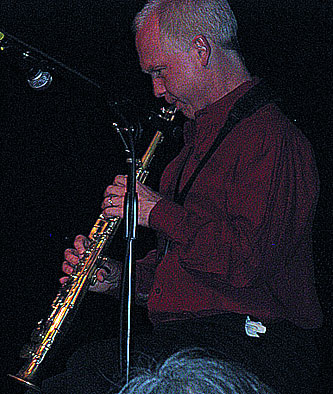 I
arrived at the design of these instruments over a 10-year period of
evolution and personal artistic expansion, for lack of a better term.
My first extended-range instrument was made for me by Santa Cruz back
in 2004. This was a 6-string baritone, but tuned to F#. Baritones
are usually tuned to C or B, so the F# instrument was a big step forward
in expanding the range of baritone. The following year, I designed
the 12-string extended baritone; also in F#. I used it almost exclusively
in altered tunings. This was my main instrument from 2005 to 2010,
when I invented the 14-string Contraguitar, which was beautifully
built for me by Dan Roberts at Daniel Roberts Stringworks in Montana.
An aside: in 2008, I developed the 12-string Alto guitar with Santa
Cruz. This instrument is pitched a fourth higher than concert 6-string
tuning. The advent of the Alto allowed me to extend the guitar's treble
register, just as the Contras extended the bass registers. The Alto
provided a lovely counterpart to the Contras. The Contraguitar is
a full octave lower than concert-tuning 6-string guitar at its core;
plus the 14-string version has one additional treble course, a high
A. The following year, I commissioned Dan to build a 16-string Contraguitar;
this expanded on the 14-string Contra by way of a high D treble course
above the high A course. That was so successful for me that I sent
the 14-string back to him and asked him to covert it to a 17-string:
the addition of the treble high D course, and on the bass side, a
single course low B below E. Those were my two main instruments for
a couple of years; I kept the 17-string in octave tunings, and the
16-string in altered tunings. You can hear these instruments on Dreaming
As I Knew (14-string Contraguitar, 12-string Alto guitar ), and
Nowhere, Now Here (30-string Contra-Soprano guitar, 17-string
Contraguitar, 16-string Contraguitar). The Contraguitars were a whole
new world for me, but the lines between them immediately began to
blur. It began to feel limiting to me to be locked in to either octave
or altered tunings for an entire composition; simultaneously I began
hearing and composing pieces for both tunings within the same composition.
Same for the Contraguitar and the Alto guitar: I was internally hearing
and them composing these incredibly wide-range compositions for both
Contra and Alto guitar within the same composition.
I
arrived at the design of these instruments over a 10-year period of
evolution and personal artistic expansion, for lack of a better term.
My first extended-range instrument was made for me by Santa Cruz back
in 2004. This was a 6-string baritone, but tuned to F#. Baritones
are usually tuned to C or B, so the F# instrument was a big step forward
in expanding the range of baritone. The following year, I designed
the 12-string extended baritone; also in F#. I used it almost exclusively
in altered tunings. This was my main instrument from 2005 to 2010,
when I invented the 14-string Contraguitar, which was beautifully
built for me by Dan Roberts at Daniel Roberts Stringworks in Montana.
An aside: in 2008, I developed the 12-string Alto guitar with Santa
Cruz. This instrument is pitched a fourth higher than concert 6-string
tuning. The advent of the Alto allowed me to extend the guitar's treble
register, just as the Contras extended the bass registers. The Alto
provided a lovely counterpart to the Contras. The Contraguitar is
a full octave lower than concert-tuning 6-string guitar at its core;
plus the 14-string version has one additional treble course, a high
A. The following year, I commissioned Dan to build a 16-string Contraguitar;
this expanded on the 14-string Contra by way of a high D treble course
above the high A course. That was so successful for me that I sent
the 14-string back to him and asked him to covert it to a 17-string:
the addition of the treble high D course, and on the bass side, a
single course low B below E. Those were my two main instruments for
a couple of years; I kept the 17-string in octave tunings, and the
16-string in altered tunings. You can hear these instruments on Dreaming
As I Knew (14-string Contraguitar, 12-string Alto guitar ), and
Nowhere, Now Here (30-string Contra-Soprano guitar, 17-string
Contraguitar, 16-string Contraguitar). The Contraguitars were a whole
new world for me, but the lines between them immediately began to
blur. It began to feel limiting to me to be locked in to either octave
or altered tunings for an entire composition; simultaneously I began
hearing and composing pieces for both tunings within the same composition.
Same for the Contraguitar and the Alto guitar: I was internally hearing
and them composing these incredibly wide-range compositions for both
Contra and Alto guitar within the same composition.
I wanted to combine the Contra and the Alto into a single instrument
so that I could achieve and realize these compositions. But the massive
pressure of 29 strings would collapse any wood guitar. To wit: the
pounds / pressure on a 6 string, steel-string acoustic is around 140-160
pounds. On a 12 string, it's up to around 220 pounds. On the 30 string,
it is over 500 pounds. It's far beyond that on the 36. It was about
this time that I heard of Alistair Hay, a brilliant and adventurous
luthier at Emerald Guitars in Ireland; he was building instruments
which contained no wood: everything was all carbon fiber. Carbon fiber
is a rather magical material for instruments in that it is stronger
than steel, but still very lightweight and resonant. I met Alistair
and proposed my idea of the combined Contra and Alto guitars into
a single instrument. He was excited about it, and agreed to build
it. During the design phase, I added an octave string to the low B,
bringing the string count up to 30; that instrument is the 30-string
Contra-Soprano guitar. It arrived in 2013 and overnight became my
main instrument; I used it rather extensively on Nowhere, Now Here.
As soon as it arrived, I began speaking with Alistair about my concept
of a double Contraguitar: two 18-string Contraguitars on one body.
Again, he was excited about this possibility, and in early 2014, the
Double Contraguitar arrived. Carbon fiber was not only the perfect
vehicle for these instruments; they couldn't exist without it. Now
my main instruments are the 30 and the 36; in fact, I hear them and
approach them as two halves of the same instrument; in my mind it's
a single 66-string instrument that happens to be split into two physically
separate instruments.
Right now, there are two more instruments in the works with Alistair
and Emerald; the first of these is an 18-string classical guitar,
and should be completed in time to press into service on the recording
sessions of the next record of Carl and I.
mwe3: On Watercolor Sky, Carl is playing alto flute
which is a new instrument for him. Where and when was the instrument
built? How did he use that instrument to color his sound on the new
CD and how does playing with alto flute bring out certain timbers
in the guitar? How does alto flute compare sonically to other types
of flutes?
Carl Clements: My alto flute is a 2012 Jupiter DiMedici. I
had been wanting an alto flute for years, and finally reached a point
where I felt I could afford to buy one. I think it’s added a
lot to our recordings. It allows me to get a deeper, richer sound,
and explore a lower flute register. I might like to record some tracks
in the future in which I use both the alto flute and the regular C
flute in order to explore a more extended flute range. This expanded
range is very compatible with the large range Kevin has available
on his 36 string Double Contraguitar. I have a similar situation with
soprano and tenor saxophones, and I have bansuri flutes in many different
registers.
mwe3: Many of the other Greydisc CDs were recorded in a few
days but the Watercolor Sky album was recorded over a longer
period of time, from the winter into the spring of 2014. How did taking
longer to work and record the tracks on Watercolor Sky during
different seasons impact the feel or mood of the tracks?
 Kevin
Kastning: Because Carl and I live about an hour away from each
other, we can work in shorter recording sessions than my other projects,
which are usually one or two all-day studio days. As it turned out,
the sessions for the album that would become Watercolor Sky
were spread out mostly over autumn and winter 2013/2014. I have a
deep resonance with both of those seasons as they exist in New England.
They're very intense and yet for me, also spiritual. I suspect this
had an impact on our concepts and performances during the recording
sessions.
Kevin
Kastning: Because Carl and I live about an hour away from each
other, we can work in shorter recording sessions than my other projects,
which are usually one or two all-day studio days. As it turned out,
the sessions for the album that would become Watercolor Sky
were spread out mostly over autumn and winter 2013/2014. I have a
deep resonance with both of those seasons as they exist in New England.
They're very intense and yet for me, also spiritual. I suspect this
had an impact on our concepts and performances during the recording
sessions.
Carl Clements: Generally speaking, Kevin and I can record our
CDs at a more leisurely pace than other Greydisc artists since we
live relatively close to each other. This is a nice luxury that allows
us to create a number of tracks to choose from. I’m not sure
that we’ve deliberately set out to do seasonally-inspired tracks,
but since both Kevin and I are both strongly inspired by the seasons,
I’m sure that they affect the mood in significant ways.
mwe3: What kinds of tunings to you use on the Watercolor
Sky tracks? Were there any very unusual tunings that were used
and what are your favorite keys to record in?
Kevin Kastning: Carl and I only approach finite keys as they
relate to the bansuri flute that he is using on a given piece, as
each bansuri is pitched in a specific key. Otherwise, we don't discuss
keys, but do discuss tonal centers and harmonic references. It's usually
more of a pan-tonal approach. The tunings I used were the full octave
tunings and my various intervallic tunings.
Carl Clements: I’ll mostly leave this one to Kevin. But
I’d say that most of our tracks don’t end up being limited
to a single key. Sometimes we’ll settle into a more limited tonal
area, but I think that more often we travel through many key areas,
or take a more atonal approach.
mwe3: What was involved in the manufacture and maintenance
of the 36 string guitar? Where was it made and how much influence
did you have in its design? Is the art form and practice of playing
the 36 a growing thing? What kind of strings was the instrument designed
to use?
Kevin Kastning: It was made in Ireland, and while it was my
invention, the design was in many ways divided between Alistair and
I. I explained the specs and requirements to him; elements like number
of strings, scale length, tunings, string gauges and types, spacing
and spread at the nut and bridge, type of tuners, soundholes, neck
profiles, action measurements, and fingerboard radius. He then suggested
the body type and size and dimensions, and set about designing things
like the peghead size and shape (a big task for an 18-string neck
with mixed guitar and bass tuners), the bridge design, which is very
critical and rather difficult when using mixed sets of guitar and
bass strings, the voicing, and various structural issues. I am an
artist endorser for Emerald, as well as K&K Sound, makers of my
favorite pickups. Alistair and I worked with Dieter Kaudel at K&K
to design the stereo pickup systems specifically for these instruments.
The strings on each neck are a mix of guitar and bass strings, and
on the 36, the gauges range from .125 to .012, and utilize various
winding compounds. I am also an artist endorser for John Pearse Strings,
so all strings are by John Pearse.
mwe3: Carl, what was it like to perform and record with Kevin's
36-string Double Contraguitar? Did you have to change your approach,
did you select different instruments to pair with it, did it affect
any of your range or what you'd normally play?
 Carl
Clements: Aside from issues I’ve addressed in answering some
of the previous questions, I don’t think my instrument selection
or range choice was strongly affected by the pairing with Kevin’s
36 string Double Contraguitar. I try to use all of my main instruments
in our recording sessions, and I usually explore a fairly wide range
on all of them. But the textures Kevin is able to create on this instrument
definitely inspire explorations in new directions for both of us.
Carl
Clements: Aside from issues I’ve addressed in answering some
of the previous questions, I don’t think my instrument selection
or range choice was strongly affected by the pairing with Kevin’s
36 string Double Contraguitar. I try to use all of my main instruments
in our recording sessions, and I usually explore a fairly wide range
on all of them. But the textures Kevin is able to create on this instrument
definitely inspire explorations in new directions for both of us.
mwe3: How do you both grow as musicians? Is it something to
do with the practicing, rehearsing and studying side and do you feel
you can you improve as musicians by listening to genres of music that
are sometimes totally outside of your own musical spheres? What are
some of your secrets that help you improve both as a musicians and
as a composers / artists?
Kevin Kastning: I maintain a daily practice regimen. My "practicing"
instruments are the 30-string Contra-Soprano guitar, the 36-string
Double Contraguitar, and 6-string classical guitar. I recently acquired
a psaltery; that is certainly expanding my thinking as I begin to
learn it. I keep a notebook of manuscript paper next to me when I
practice; often a practice session transmogrifies into a composing
session. To clear myself out, I play piano, and when composing non-guitar-based
compositions, I use piano exclusively. I listen to music every day.
Right now, for artists outside my genre, I'm listening to R. Carlos
Nakai; a Native American flautist, and Byungki Hwang. Though both
are probably outside my genre, if in fact I have a genre, both are
certainly influential. I am usually reading a music research or reference
book; at present I'm reading "The Classical Style: Haydn, Mozart,
Beethoven" by Charles Rosen. This book has caused me to reassess
many things; for example, the Haydn string quartets. I've been listening
to those rather intensely over a year now. Increasing my depth of
knowledge and understanding of these music's never fails to have a
deep impact on what I do and further serves to expand my own work;
both as a composer and performer. I'm also currently focusing on listening
to and analyzing Schubert's last three piano sonatas. I've started
sketching out a solo composition based on some of the elements in
Schubert's D. 959.
Time spent in nature is essential for me as well. I live kind of out
in the woods in New England, and I go out in all weather, almost every
day, whether it's just a short meander in the forest around my house,
or a longer expedition on nearby hiking trails.
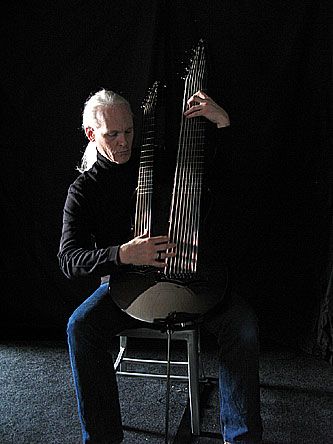 Carl
Clements: I practice as much as I can on a daily basis in order
to maintain and develop my technique, to increase my repertoire in
jazz and Hindustani classical music, and to explore new directions.
I also compose my own music, which I believe helps me to consolidate
and conceptualize many of the ideas that I’ve been developing
through improvisation. I’m also an ethnomusicologist as well
as a musician. Much of my inspiration to become an ethnomusicologist
came from my desire to understand music on as many levels as possible,
and in as many diverse forms as I can encounter. There are far too
many musical forms in this world for me to hope to really understand,
however, so my primary concentrations as a performer are jazz, Hindustani
classical, and various forms of creative improvisation. So as much
as I love Persian classical music or West African drumming, for example,
I realize that these and numerous other music's will probably remain
more peripheral influences. I listen to a variety of music's, but
jazz and Hindustani classical music provide me with my most solid
foundations as a player. As much as I love jazz and enjoy playing
more “traditional” styles like bebop, the true appeal of
jazz for me is its flexibility as a platform for improvisation and
its historical and present inclusiveness, at least in the hands of
the musicians I most admire, such as John Coltrane, Wayne Shorter,
Miles Davis, Duke Ellington, etc... But I wouldn’t try to put
a label on the kind of music Kevin and I do together.
Carl
Clements: I practice as much as I can on a daily basis in order
to maintain and develop my technique, to increase my repertoire in
jazz and Hindustani classical music, and to explore new directions.
I also compose my own music, which I believe helps me to consolidate
and conceptualize many of the ideas that I’ve been developing
through improvisation. I’m also an ethnomusicologist as well
as a musician. Much of my inspiration to become an ethnomusicologist
came from my desire to understand music on as many levels as possible,
and in as many diverse forms as I can encounter. There are far too
many musical forms in this world for me to hope to really understand,
however, so my primary concentrations as a performer are jazz, Hindustani
classical, and various forms of creative improvisation. So as much
as I love Persian classical music or West African drumming, for example,
I realize that these and numerous other music's will probably remain
more peripheral influences. I listen to a variety of music's, but
jazz and Hindustani classical music provide me with my most solid
foundations as a player. As much as I love jazz and enjoy playing
more “traditional” styles like bebop, the true appeal of
jazz for me is its flexibility as a platform for improvisation and
its historical and present inclusiveness, at least in the hands of
the musicians I most admire, such as John Coltrane, Wayne Shorter,
Miles Davis, Duke Ellington, etc... But I wouldn’t try to put
a label on the kind of music Kevin and I do together.
mwe3: What’s been the reaction of radio and print and
web to your music? Is your music getting airplay in the U.S. and what
other parts of the world are listening to your sound? How does the
internet continue to expand your sound? Also what do you think about
youtube? Is it good for music or bad?
Kevin Kastning: I feel very fortunate in that international
radio and other media outlets, both in the US and other countries,
have always been very receptive and supportive of my music; somewhat
surprising to me because my work is not what I'd call "accessible,"
as much as I highly dislike that word. Various magazines have been
very supportive, such as Guitar Player, Acoustic Guitar, FAME Magazine,
and others; including and especially MWE3. I receive emails from listeners
literally all over the world, telling me what my music means to them.
A couple of years ago, I received a very heartfelt email from an artistic
photographer in Russia who told me that it was my music that encouraged
him to keep pursuing his art when he was about to give up on it. And
again, for all the outpouring of support, I am very grateful.
Regarding YouTube, I think it's a mixed bag. I frequently use it as
a massive music reference library; for example, if I run across a
reference in the Charles Rosen book of a piece I don't have on CD,
I'll run over to YouTube and find it and listen. I've purchased many,
many CDs based on this: I don't rely on YouTube; I'd rather own the
CD. It's far more convenient for me, and I like to support the artists
to whom I'm listening. Sadly, I suspect I'm in the minority on this
approach. I have started to slowly add some of my own music (and our
music with Carl) to my YouTube channel. I think it's a good way to
expand our audience; whether or not this will result in increased
record sales (or download sales) is yet to be determined, but that's
not really why I'm making it available on YouTube. For my music, I
think of YouTube as another media outlet; like radio, for example.
I don't think that all internet outlets are artist-friendly or helpful;
I think Spotify is the enemy of the artist. Exposure is provided,
yes; but royalties are almost nonexistent. In my opinion, Spotify
exists by exploiting artists. Regardless, in many ways it is a new
and exciting time in the music industry. The new methods and ways
are still forming.
 Carl
Clements: It’s still a bit early in terms of reviews, but
the initial responses we’ve gotten have been very positive. Judging
by the pre-review comments, I’m optimistic about getting some
strong reviews. We seem to be getting a fair amount of airplay on
stations that are willing to explore the outer boundaries a bit. Kevin
might be more on top of all of this than me, though. YouTube is very
much a mixed blessing for people trying to make a living with their
music. In our case, though, I think releasing a few tracks on YouTube
can be good for giving people a sampling of what we do. Hopefully
those who like the tracks they hear on YouTube will choose to buy
the album. I’ve also made a number of my live performance videos
available on my website through YouTube, as these are versions that
don’t exist on any albums. I’m more skeptical about outlets
like Spotify that allow people to listen to any of the tracks anytime
while providing very little compensation to the artists. But again,
some people still choose to use such outlets in the hope that it will
raise their profiles. The question remains as to how the artists will
ultimately be compensated, as even live performance seems to be dwindling,
and the pay scale decreasing. I think there’s an uneasy relationship
right now between musicians and internet outlets, and that the new
music economy is in flux. It’s a difficult time for musicians
in many ways, and we’re still trying to figure out how to navigate
the new terrain.
Carl
Clements: It’s still a bit early in terms of reviews, but
the initial responses we’ve gotten have been very positive. Judging
by the pre-review comments, I’m optimistic about getting some
strong reviews. We seem to be getting a fair amount of airplay on
stations that are willing to explore the outer boundaries a bit. Kevin
might be more on top of all of this than me, though. YouTube is very
much a mixed blessing for people trying to make a living with their
music. In our case, though, I think releasing a few tracks on YouTube
can be good for giving people a sampling of what we do. Hopefully
those who like the tracks they hear on YouTube will choose to buy
the album. I’ve also made a number of my live performance videos
available on my website through YouTube, as these are versions that
don’t exist on any albums. I’m more skeptical about outlets
like Spotify that allow people to listen to any of the tracks anytime
while providing very little compensation to the artists. But again,
some people still choose to use such outlets in the hope that it will
raise their profiles. The question remains as to how the artists will
ultimately be compensated, as even live performance seems to be dwindling,
and the pay scale decreasing. I think there’s an uneasy relationship
right now between musicians and internet outlets, and that the new
music economy is in flux. It’s a difficult time for musicians
in many ways, and we’re still trying to figure out how to navigate
the new terrain.
mwe3: Do you feel your music would work even be more effective
in a live setting and how about live shows in the future? It would
be great to have a Greydisc music festival which could showcase several
of the label’s artists? Where and when would you like to have
that happen?
Kevin Kastning: My music with Carl and my other partners certainly
works well in live settings; I've done two European concert tours
with Sandor Szabo, and another one is in the works for 2015. Carl
and I have had performances in our area and in New York City. A Greydisc
concert festival would be great fun! Good idea, Robert.
Carl Clements: Kevin and I have done several live performances
in New York and in Amherst, MA, and we plan to do more. And I know
Kevin has done some performances abroad with Sandor Szabo and Balazs
Major in Hungary and performed in New York with Mark Wingfield. A
Greydisc music festival sounds like a great idea to me, though funding
would be an issue to contend with. It would be wonderful if Greydisc
could manage it somehow, though.
 mwe3:
What other musical activities do you have planned for this year and
next and are you planning a follow up for 2015, and what about the
other forthcoming projects on Greydisc that have been recorded and/or
that are planned for release in 2014 and 2015?
mwe3:
What other musical activities do you have planned for this year and
next and are you planning a follow up for 2015, and what about the
other forthcoming projects on Greydisc that have been recorded and/or
that are planned for release in 2014 and 2015?
Kevin Kastning: Carl and I have most of our next record already
in the can. We'll be doing some additional recording sessions this
fall to finish it. I'm in talks with Sandor about some trio (Sandor,
Carl, myself) and quartet (Sandor, Carl, Balazs Major, and myself)
recording session dates. All involved are excited about these projects;
right now it's a matter of logistics as we all live in different countries
and scheduling is arduous at best. My new album with Mark Wingfield
is slated for release on Greydisc in late October 2014. Mark and I
were in the studio in July of this year to record our 2015 album.
The 2015 record is based on a rather unusual concept for us; I even
played mandolin on two of the pieces. Mark and I are also planning
an album involving us and an orchestral string section. We'll both
be composing the orchestral parts. Sandor and I recorded a duo album
on the 2009 European tour that's yet to be released, but I think it
will be in either late 2014/early 2015. Sandor and I are also beginning
work on an album we're calling the 52-string project wherein I'll
be using the 36-string Double Contraguitar, and he'll be using his
16-string lute and 16-string guitar. Cellist David Darling and I are
still trying to get our schedules to line up for our duo album recording
sessions; I'm really looking forward to that. Same for bassist Michael
Manring and I; we're planning a second album together, and I am very
much looking forward to that. I think Wingfield and I have some concerts
in the UK next year, and Carl and I will be back in New York City
for some concerts next year as well. Additionally, dates are being
discussed for Wingfield and I in New York City in 2015. And work on
my solo album is progressing; albeit very slowly. The new instrument
that is in the works at Emerald will be used for several of these
projects, in addition to my main instruments, the 30 and 36.
 Carl
Clements: We already have some tracks recorded that will likely
be on our next recording to be released in 2015, and we’ll be
doing more recording sessions for this album in the near future. We’ve
been wanting to do a quartet recording with Kevin and I plus Sandor
Szabo and Balazs Major for a while now, and there might be a possibility
of fulfilling this wish next year. It’s difficult since Sandor
and Balazs are in Hungary, but I think we all feel a strong desire
to make it happen.
Carl
Clements: We already have some tracks recorded that will likely
be on our next recording to be released in 2015, and we’ll be
doing more recording sessions for this album in the near future. We’ve
been wanting to do a quartet recording with Kevin and I plus Sandor
Szabo and Balazs Major for a while now, and there might be a possibility
of fulfilling this wish next year. It’s difficult since Sandor
and Balazs are in Hungary, but I think we all feel a strong desire
to make it happen.
Thanks to Kevin
Kastning and Carl
Clements



